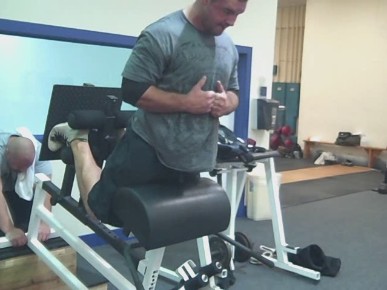Extreme Hamstring Training
How to Build Big, Powerful Legs
by Jim Smith, CSCS

It is true that there must be a balance with all training. Unfortunately, the “go” muscles of the posterior chain are most often neglected in strength programs. Lower back issues, hamstring strains and unrealized strength potential are just some of the everyday issues you will face if your training programs don’t include unilateral training AND strengthening the posterior chain (lats, erectors, glutes, hamstrings, gastrocs, soleus).
Powerlifters, athletes, strength enthusiasts, meat heads, weekend warriors and everybody else must incorporate exercises that target the posterior chain in their lower body training days. Not only for increasing your lower body strength potential and reducing your risk for injury but making sure you don’t end up looking like a lightbulb (big upper body and no legs).

The Big Posterior Chain Movements
- Chin-ups / Pull-ups
- Squats – all variations
- Deads – all variations (*really like snatch grip deads from deficit)
- Bent Over Rows
- Good Mornings
- Zercher Back Extensions
- RDL’s
- GHR
- Hip Thrusts – all variations (Contreras)
- Jump Training / Plyometrics
- Sprinting
FREE EBOOK WITH OVER 199 + MUSCLE BUILDING EXERCISES
In today’s article we are going to specifically talk about developing the hamstrings and the exercise we are going to focus on (and modify) is the glute ham raise or GHR. Muscle strength ratios are important and many researchers have attempted to define the exact percentages required for each kinetic segment. It is very difficult because these ratios “not only vary with joint angle, joint velocity and type of movement, but also with muscle group and the type of athlete. (i.e. knee extension strength vs. knee flexion strength: 60:40 ratio)” (Reference 6, Siff and Verkhoshansky)
Regardless of the exact percentages, we need to understand the basics. The surrounding, supportive, antagonistic muscle groups for each kinetic segment must be developed to ensure the integrity of the engaged joint. That is the basics, bottom line. Simple, right?
Elevated Glute Ham Raises [VIDEO BELOW]

In this article we are showing an advanced version of GHR’s. Instead of overloading GHR on a GHR bench, we are going to increase the intensity by elevating the back end of the bench with a box.
Why do this?
Because at this angle, there is constant tension on the hamstrings and there is no release of the tension. Also more of the lifter’s bodyweight is being utilized. These are no joke, trust me! Try them out and let me know in a comment below.
Which muscles are engaged with GHR’s?

“The erector spinae are active, primarily isometrically; the glutes and hamstrings raise the upper body to parallel; the glutes maintain isometric activity, and the hamstrings contract further and raise your body higher by flexing the knees; the gastrocs press against the foot plate, contracting isometrically. A glute/ham/gastroc raise lets you use the muscles of extension of the lower body one at a time.” (Reference 2, Kreis)
Alternatives
Many people don’t have access to a GHR bench. If you don’t, you can perform natural glute ham raises. This is a glute ham raise performed on the ground with someone holding (anchoring) your feet. You definitely want a pad underneath your knees for this one. They are much harder than GHR performed on the actual GHR bench. As always, these too can be progressed if you are super strong. Check out the variation below.
Natural Glute Ham Raises
A partner will hold the lifter / athlete’s feet while they perform GHR’s. This variation is much tougher than the variation done on an actual GHR bench because momentum and pad angle plays a huge role in the moment arm and percentage of the lifter’s bodyweight that is utilized.

Advanced Natural Glute Ham Raises
This variation is done on a decline sit-up bench. Because of the angle the intensity and strength requirement is off-the-charts. Only your elite athletes will be able to do this. As always, to aid in the concentric phase of the exercise, a plyometric push-up done off the bench can be incorporated.

The Programming
When do you use GHR’s?
They should be used in conjunction with squats (all variations), deadlifts (all variations), kettlebell swings, barbell hip thrusts, sprinting, etc… on your lower body days.
Volume for GHR’s on GHR Bench:
Bodyweight Only – typically 3-4 sets x 12-20 reps
Weighted (weight vest, chains, bands) – typically 3-4 sets x 8-12 reps
Volume for Natural or Advanced Natural GHR’s:
Bodyweight Only – typically 3-4 sets x 8-12 reps
Weighted (weight vest, chains, bands) – typically 3-4 sets x 6-8 reps
Resources
1. Horrigan, Joseph M., IRONMAN Magazine, August 1995 (updated 2007)
2. Kreis D.A., E.J., Speed-Strength for Football, Taylor Sports Publishing, 1992.
3. Baechle and Earle, Essentials of Strength and Conditioning 3rd Edition, NSCA, June 2008
4. Schache AG, Crossley KM, Macindoe IG, Fahrner BB, Pandy MG., Can a clinical test of hamstring strength identify football players at risk of hamstring strain?, http://www.ncbi.nlm.nih.gov/pubmed/20697691, Aug, 2010.
5. Silder A, Thelen DG, Heiderscheit BC., Effects of prior hamstring strain injury on strength, flexibility, and running mechanics., Department of Biomedical Engineering, Aug, 2010
6. Siff and Verkhoshansky, Supertraining – 6th Edition, UAC, 2009.
GHR With Back Elevated
 |
 |
 |
 |
Similar Posts:
- WARNING – Try at Your Own Risk
- Fast Five to Lower Back Health
- Fast Five to Lower Back Health
- Hardest Core Exercise – Part II – Dragon Flags with Bruce Lee Son!
- Big Deadlift Milestone for Jedd
The post Extreme Hamstring Training – How to Build Big, Powerful Legs appeared first on Diesel Crew - Muscle Building, Athletic Development, Strength Training, Grip Strength.



















